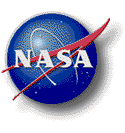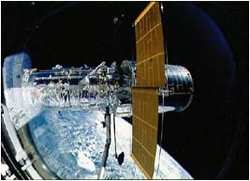Fri, May 07, 2004
NASA's O'Keefe Reportedly Sold On Robot Repair Mission To
Hubble
 Sending a robot to do the work of a
human astronaut may be just the ticket for prolonging the life of
the Hubble Space Telescope. At least, that's the thinking at NASA
HQ these days.
Sending a robot to do the work of a
human astronaut may be just the ticket for prolonging the life of
the Hubble Space Telescope. At least, that's the thinking at NASA
HQ these days.
A decision on whether that will happen, however, must be made by
early next month. Time is not on NASA's side.
Former astronaut John Grunsfield, now the chief scientist at
NASA, says it can be done -- a robot can be sent to replace the
batteries and gyroscopes. Grunsfield should know. Twice, he's been
up to repair and maintain the space telescope.
Grunsfield says a robotic mission to extend Hubble's service
life would have several elements:
- Adding a deorbital capability. That part of the plan was
already an objective for NASA, which wants to make sure that the
telescope re-enters the atmosphere safely.
- "Don't break the Hubble." In other words, Grunsfield says, if
the Hubble is still working by the time a robot mission can be
developed and launched, do no harm.
- Replace the batteries
- Replace the gyros
- If possible, add instruments that tweak the telescope's
capabilities.
 Grunsfield's argument to NASA
Administrator Sean O'Keefe was that the robotic capabilities needed
to service Hubble would be most complementary to President Bush's
"Moon, Mars and Beyond" program. He argues the same technology
needed to fix the space telescope can be used to build a lunar
colony or assist a manned mission to Mars.
Grunsfield's argument to NASA
Administrator Sean O'Keefe was that the robotic capabilities needed
to service Hubble would be most complementary to President Bush's
"Moon, Mars and Beyond" program. He argues the same technology
needed to fix the space telescope can be used to build a lunar
colony or assist a manned mission to Mars.
"So it's a win-win situation," he said.
But time is of the essence. "If we need to do something, we need
to do it fast," said Grunsfield. If Hubble is to be saved, it has
to be before the juice in the batteries runs out.
How do the scientists who know and love the space telescope feel
about a robotic mission versus an iffy chance that humans might
service the Hubble?
"We don't know yet what robotic servicing means," Beckwith told
his staff, according to Space.com. "We should be optimistic."
More News
Pilot Also Reported That Due To A Fuel Leak, The Auxiliary Fuel Tanks Were Not Used On June 4, 2025, at 13:41 eastern daylight time, a Piper PA-23, N2109P, was substantially damage>[...]
Have A Story That NEEDS To Be Featured On Aero-News? Here’s How To Submit A Story To Our Team Some of the greatest new stories ANN has ever covered have been submitted by our>[...]
From 2023 (YouTube Edition): Reflections on War’s Collective Lessons and Cyclical Nature The exigencies of war ought be colorblind. Inane social-constructs the likes of racis>[...]
Aero Linx: Colorado Pilots Association (CPA) Colorado Pilots Association was incorporated as a Colorado Nonprofit Corporation in 1972. It is a statewide organization with over 700 >[...]
High Speed Taxiway A long radius taxiway designed and provided with lighting or marking to define the path of aircraft, traveling at high speed (up to 60 knots), from the runway ce>[...]
 NTSB Prelim: Piper PA-23
NTSB Prelim: Piper PA-23 ANN FAQ: Submit a News Story!
ANN FAQ: Submit a News Story! Classic Aero-TV: One Mans Vietnam
Classic Aero-TV: One Mans Vietnam ANN's Daily Aero-Linx (07.03.25)
ANN's Daily Aero-Linx (07.03.25) ANN's Daily Aero-Term (07.03.25): High Speed Taxiway
ANN's Daily Aero-Term (07.03.25): High Speed Taxiway




